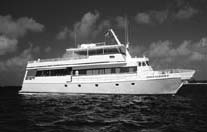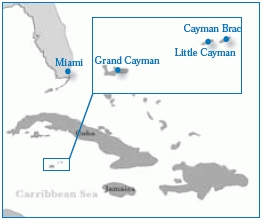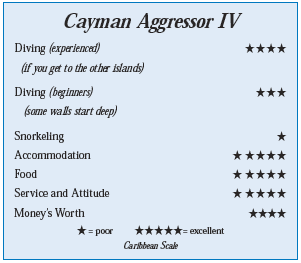Cayman Aggressor IVContents of this Issue: Industrial Oxygen in My Nitrox? Land-Based Recommendations for the Caymans The Worst Kind of Name-Dropping Galapagos Liveaboards Shut Down New Online Benefits for Subscribers Many Sunscreens are Short on Protection The Warmest Wetsuit Lining Ever? Faulty Gear? Contact Your Dealer, Not the Manufacturer Secondary Drowning: A Few Drops Can Be Fatal Pacific Lionfish Now Common in Caribbean When Lightning Strikes During a Dive Editorial Office: Ben Davison Publisher and Editor Undercurrent 3020 Bridgeway, Suite 102 Sausalito, CA 94965 a less-pricey alternative to Cayman resorts? from the September, 2007 issue of Undercurrent
Dear Reader: As I boarded the Cayman Aggressor IV in June, I fretted about the trip ahead. How would it compare to my past three years of serious Pacific diving in Fiji, Palau, and Indonesia? Any Caribbean liveaboard would have a hard act to follow. But limitations in money and vacation time mandated that I could only dive either the northern Caribbean or my local lake. I chose the former, and selected the Cayman Aggressor to dive all three Cayman Islands instead of being resort-based at one. With the Caymans going upscale and becoming less affordable, five daily dives on a liveaboard offered the better value. I was cheered by a delicious barbecue dinner and the initial briefing about the boat. Cantankerous Captain Sam of past trips was gone, replaced by an amiable Brit named Phil, who had previously steered the erstwhile Tahiti Aggressor. I had read Chapbook reports about Captain Sam making divers change into dry clothes before descending to their cabins, but Phil just asked us to conserve water and not take deck towels below. The only dark note Phil sounded was predicted high winds that might preclude the crossing to Bloody Bay Wall.
My first dive at Tarpon Alley on Grand Cayman eased
my fears about being
bored with Caribbean
diving. A small turtle
swam past as
soon as I entered
the clear, 82-degree
water. I spent most
of the dive photographing
an enormous
school of tarpon
hanging in heavy
sheets over coral
fingers grooved by
deep sand chutes.
I also renewed my acquaintance with several species of colorful
Caribbean reef fish. But ill winds were blowing at our backs. The Aggressor couldn’t make the crossing to Little Cayman on Sunday as hoped, and the seas weren’t looking promising for Monday. Captain Phil motored to dive sites near George Town for those two days and we made the obligatory visit to Stingray City (not my type of dive site because I prefer to observe wildlife in the wild). The diving at these sites was uninspiring, with limited fish and lots of dead coral. On Wednesday morning, Captain Phil announced that not only would we be unable to go to Bloody Bay Wall, the first dive was cancelled. One of the generators had failed so the boat had to seek repairs at George Town. Phil, fearing mutiny, was relieved when we divers only showed polite disappointment, mostly because the diving had been poor so far. We learned during the week that other equipment, like the air conditioning system, needed major work. The 110-foot boat, built in 1998, was clean, attractive and refitted just this year, but it seemed like the company was still playing catchup on mechanical maintenance. After the generator was repaired, the Aggressor motored to the north end, then the east end, of Grand Cayman, and the diving improved. We never made it to Little Cayman or Cayman Brac. The corals had been badly damaged by Hurricane Ivan so the real beauty appeared below 60 feet. There was typically little current and good visibility. At Hammerhead Point, the sheer wall was encrusted in branching black coral, wire coral and tangled rope sponges. A pair of eagle rays accompanied by a hawksbill turtle soared through the blue. The turtle lingered to feast on a barrel sponge and pose for photographers. French, gray, and queen angels mingled with triggerfish, small Nassau and tiger groupers, puffer fish, scrawled filefish, and juvenile spotted drums. Tall sea plumes in the shallower areas harbored slender filefish, while numerous flamingo tongues feasted on knobby sea rods. Getting back onboard was always easy on the wide ladders. I am 60 years old and
short but I trotted up the ladders under full gear as easily at the end of my 26th
dive as my first. Even with a full load of 18 divers, the dive deck felt spacious. Belizean chef Yanis, aided by Savio from southern India, served up delicious meals and snacks. Continental breakfast appeared at 6:30, followed by the full cooked meal at 7:00. I made inroads into the fresh fruit tray and nibbled a bagel or toast before moving on to eggs of all styles, omelets, or pancakes. Each lunch began with a different homemade soup -- I especially enjoyed the corn-and-pepper soup and a Caribbean version of hot-and-sour. Deli sandwiches, fajitas, or a medley of salads and pastas followed. Dinners were an interesting salad course, followed by a meat or fish entrée. The barbecued rib dinner was popular with the southerners, a tough audience. My favorite was fish spiced Belizean style. Fresh, well-prepared veggies abounded. All my meals were health spa-suitable had I not eaten the homemade cheesecake, key lime pie and bread pudding. Morning snacks were sweet and afternoon snacks savory - - banana bread and conch fritters were standouts. Savio stayed up late to pour hot cocoa for night divers and made sure the coffee addicts on board always had a fresh pot. The divers on my trip were loosely connected with one dive shop although most didn’t know each other, but dining tables clustered together in the cozy salon made it easy to start bonding. Ages ranged from mid-twenties to 60. The doctors and lawyers talked about their jobs while the rest of us talked about diving and food. The crew’s celebrity of the week was a gentleman who loved ice cream -- no matter what the dessert, he wanted ice cream, too. By the third night, the crew served him cheesecake á la mode without prompting. My standard deluxe cabin was quiet and comfortable. Big suitcases were stored on shore for the week, while my small suitcase slid easily under the bunk. Two large drawers and a closet provided decent storage but because my spouse and I could sleep comfortably together in the bottom double bunk, we also used the upper single bunk for storage. Both sides of the bunk had reading lights, and we could watch DVDs on our small television. The air-conditioning was blissfully not too cold in the cabin or the salon. A plumbing problem on the first day was repaired promptly and cleaned up thoroughly. Crew cleaned cabins daily and changed the towels. My bathroom was compact -- a curtain separated the toilet from the shower -- but adequate, with plenty of hot water and water pressure. At Rum Point, I swam over the blue along a sheer wall, watching schools of horse-eye jacks, yellow jacks and Creole wrasse well up beneath me. As I topped the wall, four eagle rays sailed past, then back again to check me out. A dozen lobsters peeked out from crevices, but a brave one scuttled over the coral in broad daylight. I also encountered three greater soapfish, a honeycomb cowfish, and a smooth trunkfish among other critters. A pair of bridled burrfish started their dance of love as I watched. The healthiest corals I saw around Grand Cayman were at Babylon. I enjoyed the pretty swimthroughs at Trinity Caves but had more fun seeing scorpionfish and other fierce-looking creatures at the top. Exploring the expanse of white sand behind the wall, I found yellowhead jawfish, sand tilefish and a myriad of garden eels. At Round Rock, I encountered a four-foot grouper circled by a pair of midnight parrotfish. Cleaning stations dotted the surrounding coral where wrasse, Pedersen cleaning shrimp and banded coral shrimp serviced a variety of fish. I always felt like I was diving in a giant bath set at a comfortable 82 degrees. Air temperatures reached the high 80’s at midday but cooled 10 degrees at night. I spent my surface intervals on the upper deck, sometimes sunning on comfortable chaise lounges, other times relaxing at tables in the covered back deck. A wet bar area offered Coke, Diet Coke and root beer, as well as Coors and decent Chilean wines for anyone finished with diving for the day. All beverages were gratis. The salon held a library of DVDs, fish ID books and third-rate novels. Those who opted out of night dives watched movies in their cabins or lounged in the hot tub after dinner with aperitifs. I did all night dives and enjoyed seeing multiple crabs, octopi, comet stars, basket stars, peppermint shrimp, hunting yellow and southern stingrays, odd snails, a free-swimming sharptail eel, and lobsters by the dozen. Some sites offered better diving after dark than by day, and some were deeper than 50 feet. Then I too took advantage of the hot tub, pondering the day’s worth of dives. The dive crew of Jon, Kathy and Lowell gave thorough briefings. Aided by Captain Phil, they worked the dive deck and quickly learned the preferences and practices of each diver. By the second day, they knew who handed up just camera and fins and who also handed up weights and BCs. Crew carried gear down to the dive platform for one woman with back problems. Lowell cheerfully served as a dive buddy for an inexperienced single diver. No one questioned my dive times and profiles, I just signed back onto the deck with my maximum depth and time. Divers could choose to go their own way underwater in groups of two to four. A full array of safety equipment was onboard, and a skiff was always in the water when divers were. But at Bonnie’s Arch, I was dropped without warning into a ripping current. I kicked valiantly to the edge of the wall, thinking I would drop down behind the coral for shelter from the current. Not so. While I glimpsed the arch, the view wasn’t worth the effort. Several divers missed their safety stops, feeling it was safer to get back onboard. The current’s strength surprised the crew as well, so a divemaster went into the water first at the next site to check the current. Even some of the less attractive sites rewarded me for my efforts. I saw diamond blennies, arrow gobies, and saddled gobies. Giant anemones seethed with tiny banded clinging crabs. Arrow crabs and neck crabs teemed over the reefs. And I actually saw a ciliated false squilla -- not so dramatic as its Pacific cousins in the same mantis shrimp family, but still cool. Was the Cayman Aggressor worth its hefty ticket price, plus a $100 fuel surcharge? Had we made the crossing to Little Cayman and Cayman Brac, my answer would be a resounding yes. Cayman’s North End and East End provide good diving, but a week diving only Grand Cayman sites from a liveaboard is disappointing when you’re expecting to visit other islands. And not making the crossing to Bloody Bay Wall rankled, especially when I learned that the Nekton Rorqual had made the crossing that same week. A review of the past year’s Captain’s Logs on the Aggressor Fleet’s website revealed that the Cayman Aggressor made the crossing to Bloody Bay Wall on 27 out of 35 cruises. The Aggressor Web site says the surcharge is there because most fuel is consumed by the generators, regardless of travel distance. Sure, fuel costs are higher, but the reasoning seems frivolous. My dive group did not have to pay the fee, but that was only because we booked through a dive shop, which had to cajole and threaten the company into negating the charge. A group of independent divers would have had to pay it. Still, it’s always easier to dive from a liveaboard. Land resorts like Little Cayman Beach Resort and the Southern Cross Club charge $2,000 to $3,200 for a fullmeal plan with only three dives a day. I dove five times a day, followed by night dives, with bottom times limited only by deco limits and my own air consumption. I paid $100 for unlimited Nitrox fills, while land-based resorts charge $10 to $15 per tank. Dives were diverse and filled with enough critters to keep everyone, from the one newbie on board to old-timers like me, satisfied. The boat has a good crew and captain in place, but Aggressor Cruises needs to take care of mechanical issues. They should also think twice about that fuel surcharge when they’re not taking divers to two out of three destinations they paid to dive at. --P.A.K.
|

I want to get all the stories! Tell me how I can become an Undercurrent Online Member and get online access to all the articles of Undercurrent as well as thousands of first hand reports on dive operations world-wide
| Home | Online Members Area | My Account |
Login
|
Join
|
| Travel Index |
Dive Resort & Liveaboard Reviews
|
Featured Reports
|
Recent
Issues
|
Back Issues
|
|
Dive Gear
Index
|
Health/Safety Index
|
Environment & Misc.
Index
|
Seasonal Planner
|
Blogs
|
Free Articles
|
Book Picks
|
News
|
|
Special Offers
|
RSS
|
FAQ
|
About Us
|
Contact Us
|
Links
|
3020 Bridgeway, Ste 102, Sausalito, Ca 94965
All rights reserved.


 The crew didn’t object
to my 70-minute dive time and draped me in a
warm towel after I left the hot deck showers.
The crew didn’t object
to my 70-minute dive time and draped me in a
warm towel after I left the hot deck showers. Aluminum 80’s were filled in the dive
stations to 3,000 psi. I initially set
up my dive gear, then the crew assisted
as needed. A covered bench stored
my mask, light and other gear. I hung
my wetsuit above my tank and placed my
fins in a rack on the dive platform.
With nine photographers on board, the
three-tiered camera table was full but
there were plenty of power strips.
Aluminum 80’s were filled in the dive
stations to 3,000 psi. I initially set
up my dive gear, then the crew assisted
as needed. A covered bench stored
my mask, light and other gear. I hung
my wetsuit above my tank and placed my
fins in a rack on the dive platform.
With nine photographers on board, the
three-tiered camera table was full but
there were plenty of power strips.  Diver’s Compass: Cayman Aggressor IV rates go from $2,095 for a twin
to $2,495 for a suite . . . Divers over age 65 get a $100 discount .
. . Unlimited Nitrox fills for $100 . . . Plankton blooms in spring
and autumn can reduce visibility, and the worst time for crossing to
Little Cayman and Cayman Brac is during the rainy season, starting
in May and peaking in October . . . American Airlines has the most
frequent and cheapest flights to George Town via Miami, ranging from
$345 to $500 for fall/winter flights . . . Aggressor Cruises provided
transport to and from the airport; those with later return flights
could be dropped at the Comfort Inn on Seven Mile Beach to use the pool and beach
facilities for free . . . Web site:
Diver’s Compass: Cayman Aggressor IV rates go from $2,095 for a twin
to $2,495 for a suite . . . Divers over age 65 get a $100 discount .
. . Unlimited Nitrox fills for $100 . . . Plankton blooms in spring
and autumn can reduce visibility, and the worst time for crossing to
Little Cayman and Cayman Brac is during the rainy season, starting
in May and peaking in October . . . American Airlines has the most
frequent and cheapest flights to George Town via Miami, ranging from
$345 to $500 for fall/winter flights . . . Aggressor Cruises provided
transport to and from the airport; those with later return flights
could be dropped at the Comfort Inn on Seven Mile Beach to use the pool and beach
facilities for free . . . Web site: 